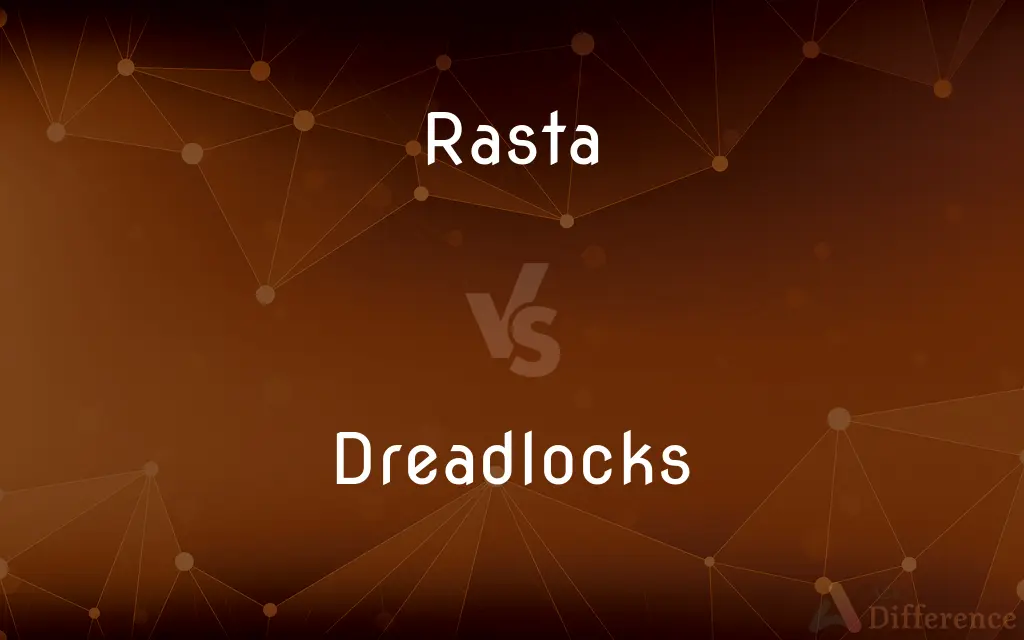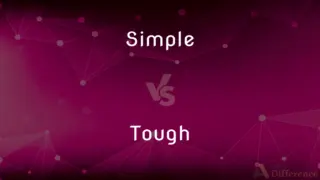Rasta vs. Dreadlocks — What's the Difference?
By Tayyaba Rehman — Updated on November 7, 2023
Rasta refers to a member of the Rastafari movement; dreadlocks are matted coils of hair. Rasta is a belief, dreadlocks a hairstyle.

Difference Between Rasta and Dreadlocks
Table of Contents
ADVERTISEMENT
Key Differences
Rasta, short for Rastafari, is a religious and social movement originating in Jamaica in the 1930s, emphasizing a connection to the African continent and the rejection of Western society's oppressive structures. Dreadlocks are a hairstyle consisting of matted ropes of hair, which have been worn by various people throughout history but are often associated with the Rastafari movement due to its symbolic significance within the culture. For Rastas, dreadlocks are a manifestation of their vow to live a natural lifestyle, which includes the Nazirite vow of abstaining from cutting one's hair.
Rasta is centered around the worship of Haile Selassie I of Ethiopia, whom followers believe to be the returned messiah and a symbol of African kingship and redemption. Dreadlocks, within the Rasta community, are a symbol of the Lion of Judah, a representation of Selassie and a symbol from the Biblical tribe of Judah. The Rasta movement is about a return to cultural roots and resistance to oppression, while dreadlocks serve as a physical representation of these values and a rejection of conventional beauty standards.
Rastas often adhere to specific dietary restrictions, eating what they call "ital" food, which is natural and unprocessed, as a part of their spiritual practice. Dreadlocks for Rastas are not merely a hairstyle but a part of their spiritual and physical purity, reflecting their commitment to natural living. Each dreadlock is seen as a root, symbolically connecting the Rasta to the earth and their cultural heritage.
The Rasta philosophy promotes living in harmony with the environment and a peaceful existence, which includes the rejection of materialism and societal norms. Dreadlocks, in the Rasta faith, are more than just a style; they are a statement of defiance against a society that values conformity. The Rasta movement has its own language, symbols, and practices, with dreadlocks being one of the most recognizable outward expressions of Rasta identity.
Both Rasta and dreadlocks are rich with historical and cultural significance. The Rasta movement can involve a deep spiritual journey and a commitment to certain moral and ethical principles. Dreadlocks, as embraced by Rastas, are not just a hairstyle but an integral part of their cultural and spiritual expression, signifying a lifelong commitment to their beliefs and a visual marker of their identity.
ADVERTISEMENT
Comparison Chart
Definition
A member of the Rastafari movement
A hairstyle of matted coils of hair
Origin
Jamaican religious and social movement
Ancient hairstyle, adopted by Rastas
Symbolism
Spiritual devotion, African identity, resistance
Natural living, spiritual vow, rejection of vanity
Cultural Association
Haile Selassie I, reggae music, ital living
Often associated with Rasta culture but not exclusive
Practices
Ital diet, chanting, marijuana as sacrament
Worn as a spiritual covenant or fashion choice
Compare with Definitions
Rasta
Rasta embodies a lifestyle of natural living and spiritual awareness.
He lived as a Rasta, following a strict ital diet.
Dreadlocks
Dreadlocks can be a fashion statement or symbolize a spiritual journey.
His dreadlocks were a testament to his ten-year spiritual journey.
Rasta
Rasta is an adherent of the Rastafari movement.
The Rasta spoke passionately about the teachings of Haile Selassie.
Dreadlocks
Dreadlocks are ropelike strands of hair formed by matting or braiding.
She adorned her dreadlocks with beads and shells.
Rasta
Rasta is often associated with reggae music and its messages of social resistance.
The Rasta musician used his music to spread messages of love and unity.
Dreadlocks
Dreadlocks require a commitment to grow and maintain.
Maintaining her dreadlocks took patience and care.
Rasta
Rasta is someone who identifies with the African diaspora and Rastafari spirituality.
As a Rasta, she found deep connections with her African roots.
Dreadlocks
Dreadlocks can be a personal expression of one's identity and lifestyle.
His dreadlocks were an expression of his individuality.
Rasta
Rasta can refer to the philosophy that rejects Western materialism.
His Rasta beliefs led him to lead a simpler, more meaningful life.
Dreadlocks
Dreadlocks are not inherently tied to any one culture or belief system.
Across different cultures, dreadlocks have been worn for various reasons.
Rasta
A Rastafarian.
Dreadlocks
Dreadlocks, also locs, dreads, or in Sanskrit, Jaṭā, are rope-like strands of hair formed by locking or braiding hair.Dreadlocks are controversial and commonly a flashpoint of cultural appropriation, but the style is demonstrably global and ancient and multicultural. Even the name is controversial, having negative and colonial connotations.
Rasta
Rastafarianism.
Dreadlocks
A hairstyle worn by Rastafarians and others in which the hair is left to grow into long matted strings.
Rasta
Rastafarian.
Rasta
(informal) Rastafarian
Rasta
(informal) Diminutive of rastaquouère
Rasta
Follower of Rastafarianism
Common Curiosities
What are dreadlocks?
Dreadlocks are hair that is allowed to matt into ropelike strands through various methods of rolling or braiding.
Do all Rastas wear dreadlocks?
No, not all Rastas choose to wear dreadlocks, though it is a common practice.
Can anyone wear dreadlocks?
Yes, while dreadlocks are associated with Rastafari, they are worn by people from various cultures.
Is Rasta a religion?
Rasta, or Rastafari, is considered a religion and a social movement.
What does Rasta signify?
Rasta signifies a follower of the Rastafari movement, emphasizing natural living and spirituality.
How are dreadlocks formed?
Dreadlocks can form naturally over time or be started through methods like backcombing, twisting, or crocheting.
What is the Rasta view on materialism?
Rastas typically reject materialism, advocating for a simple and spiritually focused life.
Are dreadlocks just a hairstyle?
While often seen as just a hairstyle, for many they carry spiritual, cultural, or personal significance.
How do Rastas view Haile Selassie?
Rastas revere Haile Selassie as the returned messiah and a symbol of African sovereignty and redemption.
What is the significance of dreadlocks in Rasta culture?
In Rasta culture, dreadlocks are a sign of the Nazirite vow and a symbol of a natural and unaltered state of being.
What does it mean to live 'ital', as Rastas do?
'Ital' living means consuming pure, natural foods and avoiding processed substances, in line with Rasta beliefs.
Do you have to be black to be a Rasta or wear dreadlocks?
No, Rastafari is open to people of all ethnicities, and dreadlocks are worn by people from various backgrounds.
Are Rastas Christian?
Rastas often see themselves as Christians, but their beliefs include elements from various religions and African traditions.
What role does reggae music play in Rasta culture?
Reggae music, closely associated with Rasta culture, often carries themes of resistance, spirituality, and social commentary.
Can wearing dreadlocks affect one's job prospects?
Unfortunately, in some cases, dreadlocks can be viewed negatively in professional settings, although attitudes are changing.
Share Your Discovery

Previous Comparison
Lump vs. Bump
Next Comparison
Simple vs. ToughAuthor Spotlight
Written by
Tayyaba RehmanTayyaba Rehman is a distinguished writer, currently serving as a primary contributor to askdifference.com. As a researcher in semantics and etymology, Tayyaba's passion for the complexity of languages and their distinctions has found a perfect home on the platform. Tayyaba delves into the intricacies of language, distinguishing between commonly confused words and phrases, thereby providing clarity for readers worldwide.













































